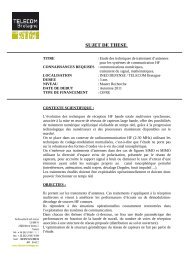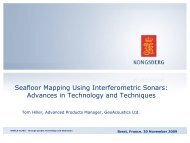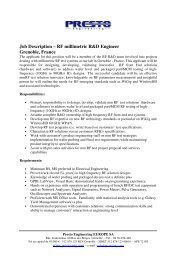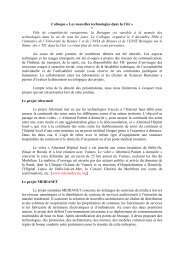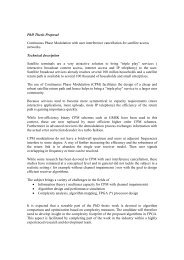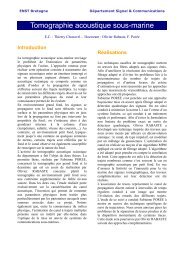Approche a-contrario pour la détection de changements sous ...
Approche a-contrario pour la détection de changements sous ...
Approche a-contrario pour la détection de changements sous ...
Create successful ePaper yourself
Turn your PDF publications into a flip-book with our unique Google optimized e-Paper software.
Sommaire<br />
Modélisation a-<strong>contrario</strong><br />
Détection <strong>de</strong> <strong>changements</strong><br />
Conclusion<br />
Choix du modèle a <strong>contrario</strong><br />
Contexte <strong>de</strong> l’étu<strong>de</strong><br />
Modélisation du problème<br />
Détection a <strong>contrario</strong><br />
Résultats asymptotiques<br />
Algorithme<br />
Résultats<br />
Choix <strong>de</strong>s paramètres m et σ du modèle H 0 :<br />
H0 a : m vecteur <strong>de</strong> R|DBR| “constant”, et σ quelconque,<br />
H0 b : m et σ quelconques.<br />
Proposition<br />
Sous les hypothèses H a 0 ou Hb 0 ,<br />
(<br />
NFA(|D|) = |D BR |C |D| |D| − L<br />
|D BR | Γ inc , δ(v D) 2 )<br />
2 2σ 2 , (6)<br />
où, <strong>pour</strong> tout x ≥ 0 et a > 0, Γ inc (a, x) = 1 ∫ x<br />
Γ(a) 0 e−t t a−1 dt .<br />
⇒ On considère H 0 avec m = 0 et σ quelconque.<br />
En pratique, σ 2 = variance <strong>de</strong> l’image BR (rien ne doit être détecté<br />
dans une image <strong>de</strong> bruit b<strong>la</strong>nc).<br />
Amandine Robin<br />
<strong>Approche</strong> a-<strong>contrario</strong> <strong>pour</strong> <strong>la</strong> détection <strong>de</strong> <strong>changements</strong> <strong>sous</strong>-pixeliques e




